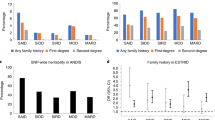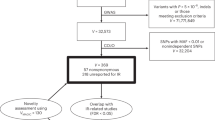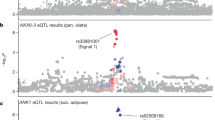Abstract
Non–insulin dependent diabetes mellitus (NIDDM) affects more than 100 million people worldwide1,2 and is associated with severe metabolic defects, including peripheral insulin resistance, elevated hepatic glucose production, and inappropriate insulin secretion3. Family studies point to a major genetic component4–6, but specific susceptibility genes have not yet been identified — except for rare early–onset forms with monogenic7–10 or mito–chondrial11 inheritance. We have screened over 4,000 individuals from a population isolate in western Finland, identified 26 families (comprising 217 individuals) enriched for NIDDM and performed a genome–wide scan using non–parametric linkage analysis. We found no significant evidence for linkage when the families were analysed together, but strong evidence for linkage when families were classified according to mean insulin levels in affecteds (in oral glucose tolerance tests). Specifically, families with the lowest insulin levels showed linkage (P = 2 × 10−5) to chromosome 12 near D12S1349. Interestingly, this region contains the gene causing the rare, dominant, early–onset form of diabetes MODY3. Unlike MODY3 families, the Finnish families with low insulin have an age–of–onset typical for NIDDM (mean = 58 years). We infer the existence of a gene NIDDM2 causing NIDDM associated with low insulin secretion, and suggest that NIDDM2 and MODY3 may represent different alleles of the same gene.
This is a preview of subscription content, access via your institution
Access options
Subscribe to this journal
Receive 12 print issues and online access
We are sorry, but there is no personal subscription option available for your country.
Buy this article
- Purchase on SpringerLink
- Instant access to full article PDF
Prices may be subject to local taxes which are calculated during checkout
Similar content being viewed by others
References
King, H. & Zimmet, P. Trends in the prevalence and incidence of diabetes: non-insulin-dependent diabetes mellitus. Wld. Hlth. Statist. Quart. 41, 190–196 (1988).
Harris, M.I., Klein, R., Welborn, T.A. & Knuiman, M.W. Onset of NIDDM occurs at least 4–7 yr before clinical diagnosis. Diabetes Care 15, 815–819 (1992).
DeFronzo, R.A., Lilly Lecture 1987: the triumvirate: β-cell, muscle, liver: a collusion responsible for NIDDM. Diabetes 37, 667–687 (1988).
Newman, B., Selby, J.V., King, M.C., Slemenda, C., Fabsitz, R. & Friedman, G.D. Concordance for Type 2 (non-insulin-dependent) diabetes mellitus in male twins. Diabetologia 30, 763–768 (1987).
Köbberling, J. Studies on the genetic heterogeneity of diabetes mellitus. Diabetologia 7, 46–49 (1971).
Cook, J.T.E. et al. Segregation analysis of NIDDM in caucausian families. Diabetologia 37, 1231–1240 (1994).
Bell, G.I. et al. Gene for non-insulin-dependent diabetes mellitus (maturity-onset diabetes of the young subtype is linked to DNA polymorphism on human chromosome 20q. Proc. Natl. Acad. Sci. USA 88, 1484–1488 (1991).
Froguel, P. et al. Close linkage of glucokinase locus on chromosome 7p to early-onset non-insulin-dependent diabetes mellitus. Nature 356, 162–164 (1992).
Hattersley, A.T. et al. Linkage of type 2 diabetes to the glucokinase gene. Lancet 339, 1307–1310 (1992).
Vaxillaire, M. et al. A gene for maturity onset diabetes of the young (MODY) maps to chromosome 12q. Nature Genet. 9, 418–423 (1995).
Van den Ouwenland, J.M.W. et al. Mutation in mitochondrial tRNA Leu (UUR) gene in a large pedigree with maternally transmitted type II diabetes mellitus and deafness. Nature Genet. 1, 368–371 (1992).
Virtaranta-Knowles, K., Sistonen, P. & Nevanlinna, H.R. A population genetic study in Finland: comparison of the Finnish-and Swedish-speaking populations. Hum. Hered. 41, 248–264 (1991).
Eriksson, J., Forsen, B., Häggblom, M., Teppo, A.-M. & Groop, L. Clinical and metabolic characteristics of Type 1 and Type 2 diabetes: An epidemiological study from the Närpes Community in Western Finland. Diabetic Med. 9, 654–660 (1992).
Newman, B., Austin, M.A., Lee, M. & King, M.-C. Inheritance of human breast cancer: Evidence for autosomal dominant transmission in high-risk families. Proc. Natl. Acad. Sci USA 85, 3044–3048 (1988).
Hall, J.M. et al. Linkage of early-onset familial breast cancer to chromosome 17p21. Science 250, 1684–1689 (1990).
Peltomäki, P. et al. Genetic mapping of a locus predisposing to human colorectal cancer. Science 260, 810–812. (1993).
Gyapay, G. et al. The 1993-94 Généthon human genetic linkage map. Nature Genet 7, 246–339 (1994).
Dib, C. et al. A comprehensive genetic map of the human genome based on 5,264 microsatellites. Nature 380, 152–154 (1996).
Murray, J.C. et al. A comprehensive human linkage map with centimorgan density. Cooperative Human Linkage Center (CHLC). Science 265, 2049–2054 (1994).
Kruglyak, L., Daly, M.J., Reeve-Daly, M.P. & Lander, E.S. Parametric and nonparametric linkage analysis: a unified multipoint approach. Am. J. Hum. Genet. 58, 1347–1363 (1996).
Lander, E. & Kruglyak, L. Genetic dissection of complex traits: guidelines for interpreting and reporting linkage results. Nature Genet. 11, 241–247 (1995).
Cerasi, E., Efendic, S. & Luft, R. Dose-response relation between plasma-insulin and blood-glucose loads in prediabetic and diabetic subjects. Lancet i, 794–797 (1973).
O'Rahilly, S.P. et al. Beta-cell dysfunction, rather than insulin sensitivity, is the primary defect in Type 2 diabetes. Lancet ii, 360–364 (1986).
Lillioja, S. et al. Impaired glucose tolerance as a disorder of insulin action. Longitudinal and cross-sectional studies in Pima Indians. N. Engl. J. Med. 318, 1217–1225 (1988).
Haffner, S.M., Stern, M.P., Dunn, J., Mobley, M., Blackwell, J. & Bergman, R.N. Diminished insulin sensitivity and increased insulin response in nonobese nondiabetic Mexican Americans. Metabolism 39, 842–847 (1990).
Lander, E.S. & Schork, N.J. Genetic dissection of complex traits. Science 265, 2037–2048 (1994).
Kahn, S.E. et al. Quantification of the relationship between insulin sensitivity and β-cell function in human subjects. Evidence for a hyperbolic function. Diabetes 42, 1663–1672 (1993).
Yki-Järvinen, H. Acute and chronic effects of hyperglycemia on glucose metabolism. Diabetologia 33, 579–585 (1990).
Menzel, S. et al. Localization of MODY3 to a 5-cM region of human chromosome 12. Diabetes 44, 1408–1413 (1995).
Lesage, S. et al. Linkage analyses of the MODY3 locus on chromosome 12q with late-onset NIDDM. Diabetes 44, 1243–1247 (1995).
Hanis, C.L. et al. A genome-wide search for human non-insulin-dependent (type2) diabetes genes reveals a major susceptibility locus on chromosome 2. Nature Genet. 13, 161–166 (1996).
Wold Health Organization. Diabetes mellitus. Report of a WHO study Group. Technical report Series, WHO, Geneva (1985).
Charles, M.A. et al. Risk factors for NIDDM in white population. Paris prospective study. Diabetes 40, 796–799 (1991).
Saad, M.F., Knowler, W.C., Pettitt, D.J., Nelson, R.G., Mott, D.M. & Bennett, P.H. The natural history of impaired glucose tolerance in the Pima Indians. N. Engl. J. Med. 319, 1500–1506 (1988).
Sartor, G., Schersten, B., Cariström, S., Melander, A. & Å. Persson, G. Ten-year follow-up of subjects with impaired glucose tolerance. Prevention of diabetes by tolbutamide and diet regulation. Diabetes 29, 41–19 (1980).
Dietrich, W. et al. A genetic map of the mouse with 4,006 simple sequence length polymorphisms. Nature Genet 7, 220–245 (1994).
Hastbacka, J. et al. Linkage disequilibrium mapping in isolated founder populations: diastrophic dysplasia in Finland. Nature Genet. 2, 204–211 (1992).
Weber, J.L. & Wong, C. Mutation of human short tandem repeats. Hum. Mol. Genet. 2, 1123–1128 (1993).
Galli, J. et al. Genetic analysis of non-insulin dependent diabetes mellitus in the GK rat. Nature Genet 12, 31–37 (1996).
Author information
Authors and Affiliations
Rights and permissions
About this article
Cite this article
Mahtani, M., Widén, E., Lehto, M. et al. Mapping of a gene for type 2 diabetes associated with an insulin secretion defect by a genome scan in Finnish families. Nat Genet 14, 90–94 (1996). https://doi.org/10.1038/ng0996-90
Received:
Accepted:
Issue Date:
DOI: https://doi.org/10.1038/ng0996-90



